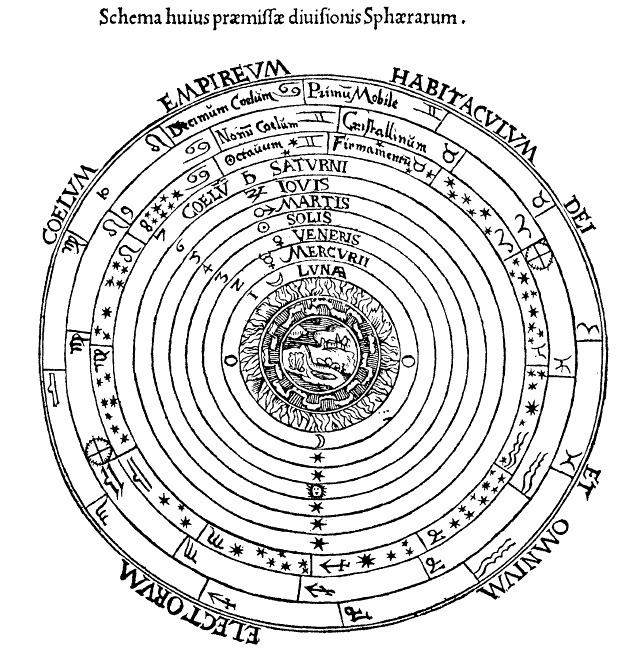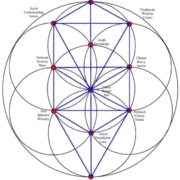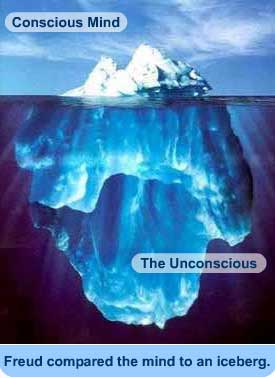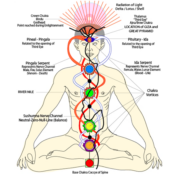Magic Squares and Gematria: Mystical Codes
Building on this astronomical system, from a numerology or arithmology perspective, in the Western occult and esoteric traditions (traditions which emerged and matured well after Christianity’s widespread adoption and canonization) each sphere is assigned a corresponding number dependent on the level of its concentric circle/sphere within the model as a whole. The Earth (unmoving) at the center in the 10th concentric and innermost sphere, and the outermost sphere associated with the indivisible Neo-Platonic One, Plato’s World Soul (Same), or Sophia in the Gnostic variants. The sphere just inside the outermost sphere of the World Soul contained the fixed stars and the Zodiac, inside of which revolved all of the (known) planets as well as the Sun and Moon, all again revolving around the fixed position Earth (Gaia).
Taking after the Babylonian tradition from which the structure (naming and symbology) of the Zodiac itself has its roots, each planetary orbit was presided over and associated with a certain deity; with Saturn (Chronos) in the 3rd sphere just inside the sphere of the fixed stars, Jupiter (Zeus) just inside Saturn in the 4th sphere, Mars (Ares) in the 5th, the Sun (Helios or Apollo) in the 6th innermost sphere, Venus (Aphrodite) in the 7th, Mercury (Hermes) in the 8th, the Moon (Selene or Hecate) in the 9th sphere, and again the Earth (Gaia) in the innermost, 10th and unmoving sphere outside of which all the other spheres revolved given the geocentric nature of the model.
Using this numerical scheme, the astral spheres, their planetary or astral association as well as their numeric equivalents can be mapped onto the Tree of Life which consists of ten interconnected symbols within which is believed to contain the (divine) mystery of the universe Kabbalistic tradition. In this model the Earth and the Moon are at the bottom most positions (positions 10 and 9 respectively), the Sun in the middle at position 6, and the outermost spheres of the One, the Fixed Stars and then Saturn (1, 2 and 3 respectively) at the top of the Tree. From this model, laying the names of the planets from numbers 3 to 9 (Saturn to the Moon) onto the points on a seven-sided polygon – a septagon or regular heptagon – and then creating a regular hexagram (six-pointed star) from each point within the heptagon, the order of the seven days of the week can be derived by connecting each of the points in the hexagram with each other inside the seven-sided heptagon.[1]
For example, taking the system of celestial spheres one step further from a numerological perspective, each of the 10 celestial spheres and their respective associated numbers can be mapped to a special mathematical construct called a magic square. A magic square consists of an arrangement of distinct numbers in a grid, or square, where each position in the X by X square is filled with one unique value from the set of X times X values, and where each row, each column, and each diagonal adds up to the figure. There is but one configuration for each magic square that has these special characteristics and these squares, and their associated deities as reflected in the astronomical system described above, was held to be of great significance, exemplifying the mystery of the divine and its relationship to number and Mathematics.
Following the breadcrumbs so to speak, the magic square of the Sun, which is represented by the number 6, is a 6×6 square where all 36 positions in the square are filled with the numbers 1-36 just once, and each row, each column, and each diagonal row when added up is equal to the number 111, a number considered sacred in these occult traditions. In this magic square, the total of all numbers in the square has the infamous value of 666, the number of the “beast” in the Book of Revelation.
Another important number for any magic square in this occult tradition is the sum of any four symmetrical numbers in the square itself, which for the magic square of the Sun is 74. 74 as it turns out is a factor of the gematria values for both the Greek words for “Jesus”, which is 888 or equals 12 x 74, as well as “Christos”, which is equal to 1480 or 20 x 74.
In ancient Greece, Apollo was one of the main Olympian gods who was associated with the Sun, light, learning, healing and music and of course prophecy from which his association at the Temple at Delphi derived. In the Olympian tradition he was the son of Zeus and Leto and the brother of Hermes, from which he received his famous lyre. His brother Hermes of course plays a prominent role in the Western occult tradition as Hermes Trismegistus, or “Hermes Thrice Great”, the Greco-Egyptian Thoth-Hermes figure who is the revealer of esoteric knowledge to mankind in the Hermetic theological tradition which flourished around the same time when early Christianity and Gnosticism took root in the Mediterranean.
Apollo’s association with the Sun, which was perceived to be the symbol of the Neo-Platonic One in the mystical traditions of antiquity (in Plato’s Allegory of the Cave for example) is explicitly referred to by Plutarch, a priest at the Temple at Delphi from the 2nd century CE, who cites the etymology of Apollo’s name being “not one”, i.e. “a-pollo”, and described the relationship between the two as:
Hence many among earlier generations regarded Apollo and the Sun as one and the same god; but those who understood and respected fair and wise analogy conjectured that as body is to soul, vision to intellect, and light to truth, so is the power of the sun to the nature of Apollo; and they would make it appear that the sun is his offspring and progeny, being forever born of him that is forever. For the sun kindles and promotes and helps to keep in activity the power of vision in our perceptive senses, just as the god does for the power of prophecy in the soul.[2]
In these traditions which provided the basis for more modern (Middle Age) Western occult traditions, this astrological system of Chaldean origin that was morphed and shaped by the Greek philosophers incorporated specific numerical symbology associated with each of the celestial spheres and their associated presiding deities, a tradition which interestingly enough could be mapped back to some of the names and relationships of the gods in ancient Greece through a practice referred to as gematria, or isopsephy in Greek. For prior to the adoption of Arabic numbers into Indo-European alphabet systems in the 8th/9th century CE, and even prior to the use of Roman numerals in Latin, numbers were written down using characters in the alphabet, each of which was assigned a numeric equivalent, rather than as designated numbers like we use today.
This numbering/encoding system is believed to have originated in the Assyro-Babylonian culture in the Near East and then passed on to Hebrew and then in turn adopted by the Greeks. For example, in Hebrew or Greek, the first ten letters of the alphabet represent the numbers 1-10, the next 9 letters represent 20 to 100 going up by 10s, and the next 9 letters representing 200-900 going up by hundreds, with additional characters/symbols added to the alphabet as necessary to complete the system. In this type of alphabetic and numeric system, words or phrases could be given numeric values by adding up, summing, the letters in a specific word or phrase, thereby allowing for mathematical and geometrical values, as well as esoteric conceptual associations, to be encoded or embedded in text and language.
In the Greek theological tradition specifically, and in turn in the Christian tradition which was of course heavily influenced by the Greeks (the New Testament was almost entirely written in Greek), there is significant evidence that gematria was used, as evidenced by some of the gematria value of some of the names of gods and/or places of worship, much of which is associated with the numerical values that are associated with the Sun, derived from the Chaldean astrological model described above.
Helios was the Greek god of the Sun, the Titan who shepherded the sun across the sky each day in his chariot driven by great fire darting steeds, and the relationship between Helios and Apollo is expressed geometrically via Hermes, whereby a circle with circumference of 353 – the gematria value for Hermes – contains within it a perfect square whose perimeter is precisely the gematria value for Helios, i.e. 318. Furthermore, 318 is the diameter of a circle with circumference 1000, which happens to be the gematria value for the phrase “The One” in Greek. 318 is also the gematria value for the letter “Theta”, whose character is very similar, and in all likelihood shares similar origins, to the symbol of the Sun in Ancient Greek and Egyptian, i.e. a circle with a dot in the center.
With respect to Apollo, Hermes and Zeus, all significant entities in the Greek pantheon, we find that the gematria value of the phrase “The God Apollo” is equal to 1415 in Greek, which happens to be the approximate geometric mean value between 1 and 2 (the square root of 2 is 1.4142), 1/4th of which is equal to 353.5, a very close approximation of the gematria value of Hermes, i.e. 353. Further intriguing is the fact that the geometric mean between 1061 and 353, the gematria values for “Apollo” and “Hermes” respectively is 612 which is the gematria value for “Zeus”. Adding further mystery is the fact that the harmonic mean value of 353 and 1061 is 531, which is the gematria value for “lyre” in Greek.
It would appear to be highly unlikely that the gematria values and their geometric relationships, along with their esoteric and symbolic meanings, are simply coincidence. Given the antiquity of the names themselves and the Greek language, it would appear that these geometric relationships, along with the underlying symbolic and esoteric relationship of the divine entities which they represent, were well understood by the early Greeks, at least going back as far as the early part of the first millennium BCE. It’s also apparent that that these symbolic, geometrical and gematria based relationships were leveraged by the early Christian theologians as well given the some of the numeric symbology of the New Testament.
[1] The hexagram starts with Sunday (Sun or 6), then connecting Monday (Moon or 9), Tuesday (Mars or 5), Wednesday (Mercury or 8), Thursday (Jupiter or 4), Friday (Venus or 7), and then Saturday (Saturn or 3). For the outline of the mapping of the astral spheres onto the Kabbalistic Tree of Life and see Jesus Christ Sun of God, Ancient Cosmology and Early Christian Symbolism by David Fideler, Quest Books 2007 pg. 236-237. For a listing of the days of the week and their names and deity equivalents in various ancient cultures see http://en.wikipedia.org/wiki/Names_of_the_days_of_the_week.
[2] Plutarch, De defectu oraculorum. Plutarch. Moralia. with an English Translation by. Frank Cole Babbitt. Cambridge, MA. Harvard University Press. London. William Heinemann Ltd. 1936. 5.. From http://www.perseus.tufts.edu/hopper/text?doc=Perseus%3Atext%3A2008.01.0251%3Asection%3D42.










and when there are no angles to preserve or protect, what then of capture and release?
the word as thought must alter from within in no certain way,
from hearing your voice, in me, in a certain way,
seeing dark spots hidden within darkspots,
this is the reader of ciphers way,
but hey,
you’ll figure it out,
affine self similarity is difficult to explain,
what a pain when pleasure you seek,
to understand your recursive synchronicity as pure projection is magic,
from one state to another does this change take place,
its capture is a quiet quitetragic moment of manipulation,
a natural occurrence leaping out,
the universe in cruelplay renew disguised as anew a balanced out refill,
milky coffee the Starbucks way,
to be bought and sold,
put my name on the cup,
marked out in bold,
collapse,
not me not you,
gimmickary at its best,
dark spots can’t hide in dark spots,
that’s not the affine way,
innocence turned on its side,
broken promises dressed up in modern styles,
not for release,
captured as a keeps sake in a muzzledpuzzlenested quest.
End
I let myself run away bit lol. so haven’t seen this post in its finished form before hitting the send button.
Like it! More breadcrumbs…
ask why an inner and outer…. both are proxy implants to bind the reader to the sale of the captured content… ask what’s not in the k,not of k,no,wing…. winging it is the way 😉